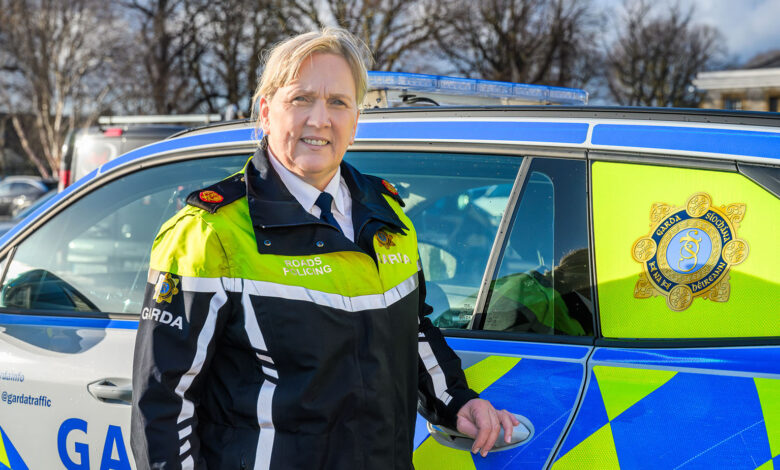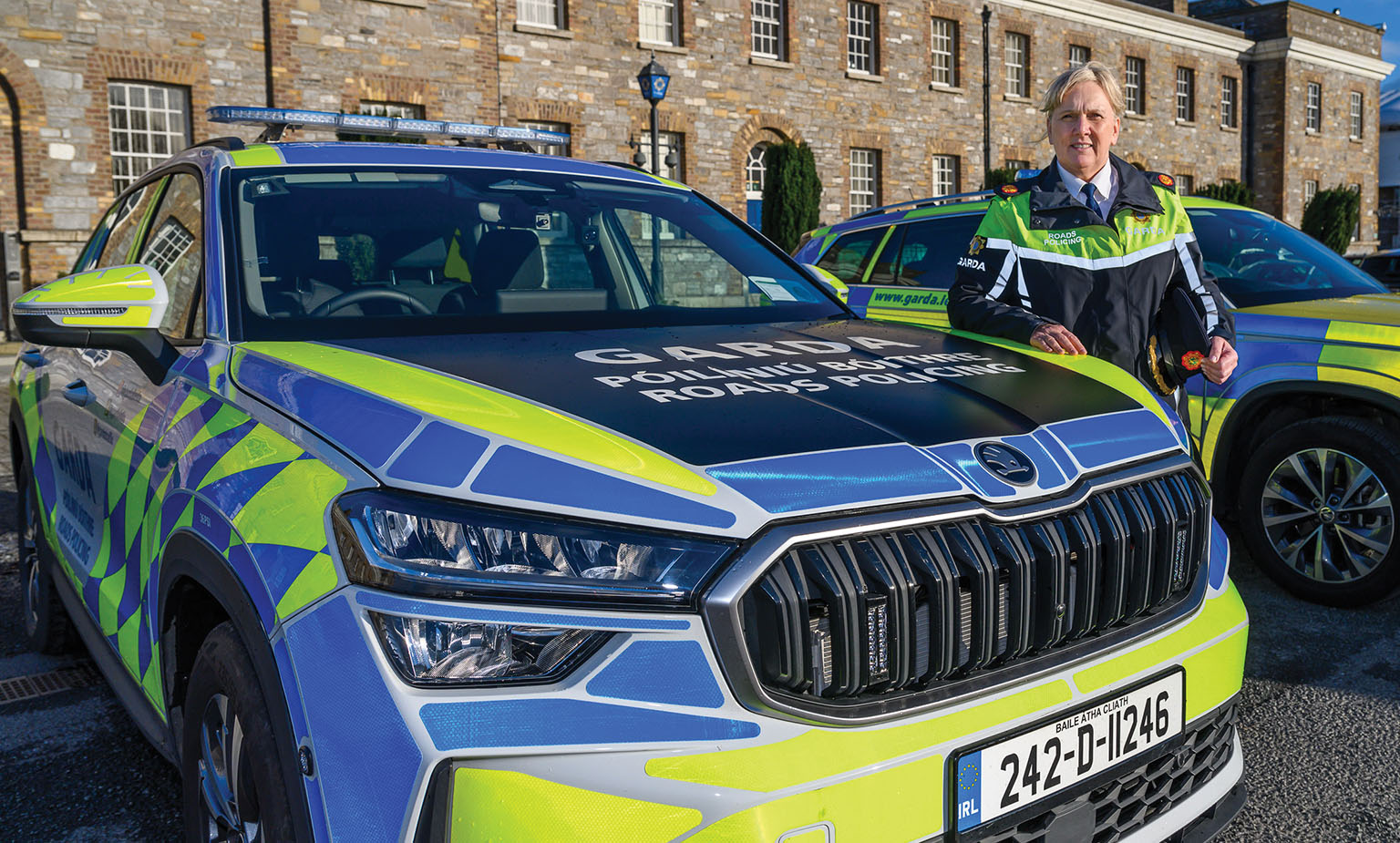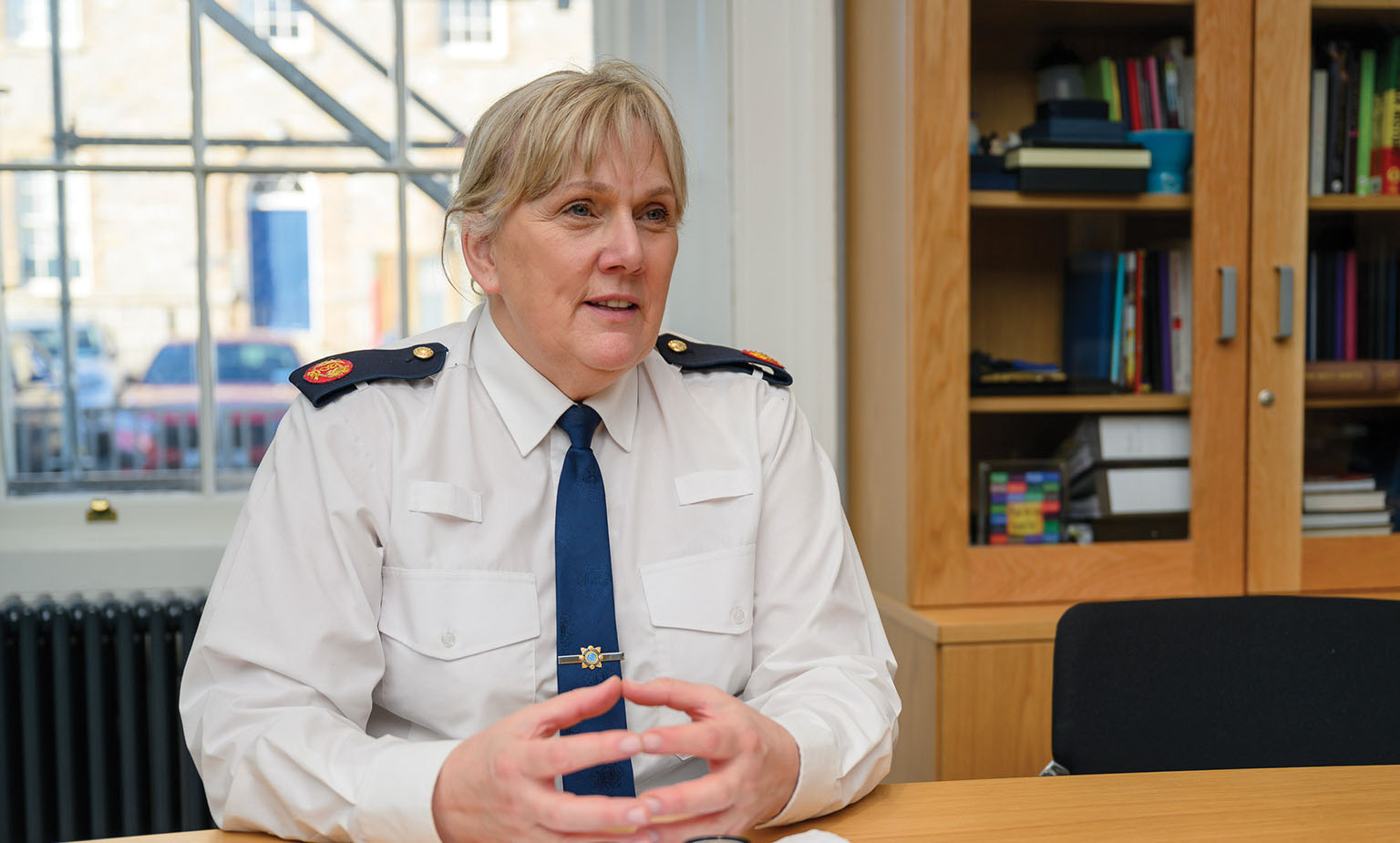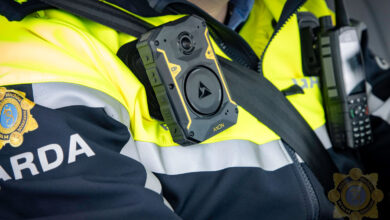Garda Assistant Commissioner Paula Hilman: ‘Reversing the trend in road deaths’

Amid an unwelcome upward trend in deaths and serious injuries on Ireland’s roads, Assistant Commissioner for Roads Policing and Community Engagement Paula Hilman meets with Ciarán Galway at An Garda Síochána’s Phoenix Park headquarters to provide an update on roads policing efforts to reverse this.
Having joined An Garda Síochána as Assistant Commissioner for Roads Policing and Community Engagement in May 2020 – at the height of the Covid-19 pandemic – Hilman reflects on how “easy it is to forget our many achievements in that difficult context”.
However, Hilman’s remit is much broader than roads policing, and she has responsibility for the Garda National Community Engagement Bureau; the Garda Youth Diversion Bureau; and the Garda National Public Order Unit; as well as leading on the roll out of the Community Access Support Team, or CAST project, in Limerick and on the national roll-out of the local community safety partnerships.
“An Garda Síochána’s focus – and mine as Assistant Commissioner with responsibility for roads policing – is to work collaboratively to reverse the current trend.”
Garda Assistant Commissioner for Roads Policing and Community Engagement, Paula Hilman
Equipped with 40 years of policing experience, in late 2024, the north Belfast native also assumed responsibility as Assistant Commissioner for the Eastern Region which incorporates counties Waterford, Kilkenny, Carlow, Laois, Offaly, Kildare, Meath, and Westmeath.
Reflecting on the broader evolution of policing in the State over the last five years, the Assistant Commissioner emphasises the continued implementation of the new Garda Operating Model which will see the organisation’s divisions reduced from 28 to 21 as per A Policing Service For Our Future.
Across each of her portfolios, Hilman explains that her work is primarily driven by a commitment to enabling frontline gardaí.
“In my Garda Headquarters role, the predominant challenge has been assisting individual members on the frontline at 3am. What equipment do they need? What training do they require? What information do they need? If we focus on answering these questions, then our members can continue to effectively and efficiently protect the public.”
Roads policing
Specifically, in roads policing, An Garda Síochána has deployed new technology – including via the Garda Active Mobility Project – “to enable our members to have ready roadside access to Garda PULSE system and data conducive to making our roads safer”.
A total of approximately 11,800 mobility devices have been rolled out to operational gardaí. Using the Traffic App, a uniformed Garda member can scan car registration plates and instantly access information relating to tax, insurance, NCT, and any police warnings relating to a vehicle.

Simultaneously, since November 2023, the Motor Insurers Bureau of Ireland (MIBI) has been providing An Garda Síochána with motor insurance information, meaning that the insurance databased within the Traffic App is updated every 24 hours. This information – relating to insurance policy details – has led to a substantial increase in detection of uninsured drivers and vehicle detentions.
“Acquiring access to insurance data has been a gamechanger for An Garda Síochána,” Hilman comments, adding: “This is an ongoing project in collaboration with the MIBI, and each month we detect an average of 2,200 people driving without insurance and we seize 1,600 cars.
“Simultaneously, we are working with the Department of Transport to determine how we can increase the information we can access in relation to the National Vehicle and Driver File (NVDF) database. This would enable frontline gardaí to quickly identify road users who are recidivist offenders.”
Garda National Roads Policing Bureau
Within An Garda Síochána, the Garda National Roads Policing Bureau (GNRPB) is primarily responsible for roads policing policy development and closely liaises with the Department of Transport, providing information to inform new legislation, and preparing the broader organisation to respond to legislative changes relating to roads policing.
A recent example is the preparation undertaken to respond to the implementation of the Speed Limit Review Group’s final report in February 2025. Published in September 2023, the report recommended that:
- the default speed limit on national secondary roads be reduced from 100km/h to 80km/h;
- the default speed limit for the local and rural roads network be reduced from 80km/h to 60km/h; and
- the default speed limit on urban roads, including built up areas alongside housing estates and town centres, be reduced to 30km/h.
“Overall, at national level, the GNRPB works in partnership with key road safety stakeholders, such as the Department of Transport, and the Department of Justice, the Road Safety Authority, Transport Infrastructure Ireland, and the National Transport Authority, among others,” the Assistant Commissioner explains.
Meanwhile, each of the 21 Garda division has its own Roads Policing Unit reporting to a divisional officer at Chief Superintendent level, while a direct link to the Assistant Commissioner at Garda Headquarters exists via the four regional Assistant Commissioners.
“The GNRPB also has meetings with the roads policing Inspectors,” Hilman explains, “while I, as Assistant Commissioner, liaise with representatives from the divisions at Chief Superintendent level. As such, we have significant internal collaboration.
“This link drives performance while acting as a conduit for feedback between roads policing gardaí and the divisions regarding the equipment and the training they need to do their job.”
“In working to reduce the frequency of death and serious injury on our roads, the application of a criminal justice approach alone will not deliver the intended outcome.”
Trends
Across each of the stakeholders involved in road safety, the predominant priority now is the post-Covid trend towards increased road deaths. While in 2021 road deaths had decreased to 130, this figure increased the two consecutive years that followed (155 in 2022 and 184 in 2023). While 2024 recorded 10 fewer road deaths than the previous 2023, the figure of 174 is still greater than the total figures of eight of the last 10 years.
“While we had recorded a significant downward trend in road deaths during the Covid pandemic, but now we have observed a significant increase,” Hilman acknowledges.
Among the chief contributors to road deaths, An Garda Síochána designates four as ‘lifesaver offences’. These are:
- failing to wear a seatbelt;
- driving under the influence of alcohol or drugs;
- using a mobile phone; and
- speeding.
“In this context, An Garda Síochána’s focus – and mine as Assistant Commissioner with responsibility for roads policing – is to work collaboratively to reverse the current trend,” the Assistant Commissioner affirms.
Response
Tasked an overarching objective of reduced road deaths – as per Our Journey Towards Vision Zero, the Government’s road safety strategy – An Garda Síochána is implementing a blend of enhanced technology, visibility, and education initiatives, alongside traditional enforcement.
“In working to reduce the frequency of death and serious injury on our roads, the application of a criminal justice approach alone will not deliver the intended outcome,” Hilman asserts. “While An Garda Síochána must play its part in terms of enforcement activity, equally we must work with local authorities and other stakeholders to construct safer roads by design, utilise technologies such as new speed cameras, and deliver education initiatives if the State is to reduce the number of deaths and serious injuries on our roads.”
Within the technology sphere, the deployment of new equipment has already had a significant role to play. “Over the last 12 months, we have rolled out a substantial amount of new equipment in relation to roads policing,” the Assistant Commissioner observes.
This includes investment in new hand-held speed detection devices, drug detection devices, automatic number plate recognition (ANPR) technology, and new high-performance vehicles, unmarked motorcycles, and an unmarked heavy goods vehicle (HGV).
Utilised as part of Operation Iompar, An Garda Síochána has deployed its unmarked HGV to target distracted driving through targeted enforcement on the dual-carriageway and motorway network throughout the State.
Speed cameras
Simultaneously, drawing insights from data relating to fatal and serious injury collisions as well as speed data, nine static cameras will come into effect in locations determined to be high risk. Funded from An Garda Síochána’s budget and costing around €2.4 million over 18 months. To date three of these have gone live on the N59 Galway; N17 Mayo; and N13 Donegal. While work is continuing on static cameras at the following six sites:
- N80, Carlow;
- N25, Kilkenny;
- N22, Cork;
- N69, Limerick;
- Dolphins Barn, Dublin; and
- R772, Wexford.
Meanwhile, in 2024, three additional average speed cameras also went operational at:
- the N3 (Butler’s Bridge);
- the N5 (Swinford); and
- the N2 (Slane).
Furthermore, Garda Commissioner Drew Harris has tasked Hilman with developing a business case for the introduction of an additional 100 static speed cameras.
“The international evidence relating to speed safety cameras demonstrates a positive correlation in changing driver behaviour and reducing speed. Given that speed is a determining factor in the severity of many collisions and is the single greatest contributor – at 30 per cent – to fatal collisions, the lower speeds people drive at, the lower the number of road deaths,” the Assistant Commissioner insists.
Visibility
In April 2024, Garda Commissioner Drew Harris instructed all uniformed gardaí to undertake a mandatory 30 minutes of road safety policing on each shift. Commenting on this initiative, Hilman acknowledges: “While we knew that many gardaí were already doing this, the initiative has instilled a more coherent focus. While it is not necessarily about enforcement, it is about being visible.”
However, visibility, she says, is not solely reliant on “being seen in our new fleet of garda liveried vehicles”, it also means visibility via social media platforms and education programmes.
“Talking about these initiatives and giving them visibility in the media, alongside our high engagement rate on social media ensures that the public know and understand that these capabilities are being deployed,” the Assistant Commissioner remarks.
Education
Education and personal responsibility is paramount to roads policing and one such initiative highlighting this is the Lifesaver Project. Delivered by gardaí in collaboration with the Road Safety Authority (RSA) and primarily aimed at the transition year and leaving certificate cohorts, the road safety education programme is “hard hitting and realistic” and aims to highlight “the devastating effects that road traffic collisions have on people’s lives”.
Trialled in Limerick over several years before rolling out nationally, now more than 200 gardaí are trained to deliver a consistent and coherent two-hour programme of interactive engagement.
North-south cooperation
Discussing the cross-border aspect of roads policing, Hilman notes north-south collaboration has “a twin aspect”. Firstly, collaboration occurs geographically along the border where operations may be undertaken concurrently. “These operations are designed and led by the local divisions in the border region, north and south,” she says.
Secondly, at Garda Headquarters level, there are regular meetings with counterparts in the PSNI. “The Chief Superintendent from the Garda National Roads Policing Bureau regularly meets with the equivalent Chief Superintendent from the PSNI. One tangible outworking of this collaboration materialised in November 2023, when – for the first time – a National Slow Down Day was implemented across the entire island,” the Assistant Commissioner recalls.
Similarly, when An Garda Síochána introduced a new roadside drug driving testing system (Drugwipe 6s) in December 2022, this was then followed by the PSNI which introduced the system on an initial 12-month pilot basis from September 2024.
“Given the volume of border crossings each day, partnership working with the PSNI is ongoing. The PSNI speak with us about our experiences and vice versa. It is very much about sharing experiences, including around campaigns that are being launched,” Hilman explains.
Vision/ambition
Having just completed the phase one action plan (2021-2024) of Our Journey Towards Vision Zero, the Government’s road safety strategy, attention has now turned to the phase two action plan (2025-2027).
“The Department of Transport and the RSA are engaging with us and other partners in terms of phase two, building on our achievements to date,” the Assistant Commissioner says.
Summarising her vision for roads policing, the Assistant Commissioner wants to consolidate the work completed in 2024 regarding the roll out of new equipment and notes the high volume of candidates in the recent recruitment competition for roads policing.
“In the immediate term, our focus is on increasing the skills capacity in roads policing, while continuing to enhance the equipment and training available to our members. In the long term, as the Government has outlined, we want to achieve Vision Zero. This means halving road traffic deaths and serious injuries by 2030 and eradicating them altogether by 2050. We cannot lose sight of that vision,” she emphasises.
Allied to this is the maintenance of An Garda Síochána’s roads policing capacity and capability. This includes the wellbeing of Garda members, many of whom are exposed to the scenes of fatal road traffic collisions.
“That is something we are cognisant of, and we have robust occupational health processes in place, but we must recognise that while our members have a job to do, they are also human beings. By looking after the wellbeing of gardaí, we enable them to keep communities safe.
“Similarly, I regularly meet with the representative groups which support families whose loved ones have been killed or seriously injured in a road traffic collision. As such, when discussing the figures relating to road deaths, I am always very conscious that behind each number is a loved one.”




